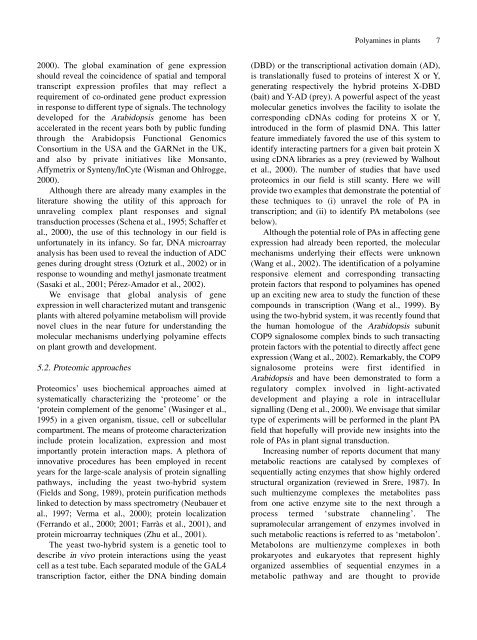(Converted)-4 - Journal of Cell and Molecular Biology - Haliç ...
(Converted)-4 - Journal of Cell and Molecular Biology - Haliç ...
(Converted)-4 - Journal of Cell and Molecular Biology - Haliç ...
Create successful ePaper yourself
Turn your PDF publications into a flip-book with our unique Google optimized e-Paper software.
2000). The global examination <strong>of</strong> gene expression<br />
should reveal the coincidence <strong>of</strong> spatial <strong>and</strong> temporal<br />
transcript expression pr<strong>of</strong>iles that may reflect a<br />
requirement <strong>of</strong> co-ordinated gene product expression<br />
in response to different type <strong>of</strong> signals. The technology<br />
developed for the Arabidopsis genome has been<br />
accelerated in the recent years both by public funding<br />
through the Arabidopsis Functional Genomics<br />
Consortium in the USA <strong>and</strong> the GARNet in the UK,<br />
<strong>and</strong> also by private initiatives like Monsanto,<br />
Affymetrix or Synteny/InCyte (Wisman <strong>and</strong> Ohlrogge,<br />
2000).<br />
Although there are already many examples in the<br />
literature showing the utility <strong>of</strong> this approach for<br />
unraveling complex plant responses <strong>and</strong> signal<br />
transduction processes (Schena et al., 1995; Schaffer et<br />
al., 2000), the use <strong>of</strong> this technology in our field is<br />
unfortunately in its infancy. So far, DNA microarray<br />
analysis has been used to reveal the induction <strong>of</strong> ADC<br />
genes during drought stress (Ozturk et al., 2002) or in<br />
response to wounding <strong>and</strong> methyl jasmonate treatment<br />
(Sasaki et al., 2001; Pérez-Amador et al., 2002).<br />
We envisage that global analysis <strong>of</strong> gene<br />
expression in well characterized mutant <strong>and</strong> transgenic<br />
plants with altered polyamine metabolism will provide<br />
novel clues in the near future for underst<strong>and</strong>ing the<br />
molecular mechanisms underlying polyamine effects<br />
on plant growth <strong>and</strong> development.<br />
5.2. Proteomic approaches<br />
Proteomics’ uses biochemical approaches aimed at<br />
systematically characterizing the ‘proteome’ or the<br />
‘protein complement <strong>of</strong> the genome’ (Wasinger et al.,<br />
1995) in a given organism, tissue, cell or subcellular<br />
compartment. The means <strong>of</strong> proteome characterization<br />
include protein localization, expression <strong>and</strong> most<br />
importantly protein interaction maps. A plethora <strong>of</strong><br />
innovative procedures has been employed in recent<br />
years for the large-scale analysis <strong>of</strong> protein signalling<br />
pathways, including the yeast two-hybrid system<br />
(Fields <strong>and</strong> Song, 1989), protein purification methods<br />
linked to detection by mass spectrometry (Neubauer et<br />
al., 1997; Verma et al., 2000); protein localization<br />
(Ferr<strong>and</strong>o et al., 2000; 2001; Farràs et al., 2001), <strong>and</strong><br />
protein microarray techniques (Zhu et al., 2001).<br />
The yeast two-hybrid system is a genetic tool to<br />
describe in vivo protein interactions using the yeast<br />
cell as a test tube. Each separated module <strong>of</strong> the GAL4<br />
transcription factor, either the DNA binding domain<br />
Polyamines in plants 7<br />
(DBD) or the transcriptional activation domain (AD),<br />
is translationally fused to proteins <strong>of</strong> interest X or Y,<br />
generating respectively the hybrid proteins X-DBD<br />
(bait) <strong>and</strong> Y-AD (prey). A powerful aspect <strong>of</strong> the yeast<br />
molecular genetics involves the facility to isolate the<br />
corresponding cDNAs coding for proteins X or Y,<br />
introduced in the form <strong>of</strong> plasmid DNA. This latter<br />
feature immediately favored the use <strong>of</strong> this system to<br />
identify interacting partners for a given bait protein X<br />
using cDNA libraries as a prey (reviewed by Walhout<br />
et al., 2000). The number <strong>of</strong> studies that have used<br />
proteomics in our field is still scanty. Here we will<br />
provide two examples that demonstrate the potential <strong>of</strong><br />
these techniques to (i) unravel the role <strong>of</strong> PA in<br />
transcription; <strong>and</strong> (ii) to identify PA metabolons (see<br />
below).<br />
Although the potential role <strong>of</strong> PAs in affecting gene<br />
expression had already been reported, the molecular<br />
mechanisms underlying their effects were unknown<br />
(Wang et al., 2002). The identification <strong>of</strong> a polyamine<br />
responsive element <strong>and</strong> corresponding transacting<br />
protein factors that respond to polyamines has opened<br />
up an exciting new area to study the function <strong>of</strong> these<br />
compounds in transcription (Wang et al., 1999). By<br />
using the two-hybrid system, it was recently found that<br />
the human homologue <strong>of</strong> the Arabidopsis subunit<br />
COP9 signalosome complex binds to such transacting<br />
protein factors with the potential to directly affect gene<br />
expression (Wang et al., 2002). Remarkably, the COP9<br />
signalosome proteins were first identified in<br />
Arabidopsis <strong>and</strong> have been demonstrated to form a<br />
regulatory complex involved in light-activated<br />
development <strong>and</strong> playing a role in intracellular<br />
signalling (Deng et al., 2000). We envisage that similar<br />
type <strong>of</strong> experiments will be performed in the plant PA<br />
field that hopefully will provide new insights into the<br />
role <strong>of</strong> PAs in plant signal transduction.<br />
Increasing number <strong>of</strong> reports document that many<br />
metabolic reactions are catalysed by complexes <strong>of</strong><br />
sequentially acting enzymes that show highly ordered<br />
structural organization (reviewed in Srere, 1987). In<br />
such multienzyme complexes the metabolites pass<br />
from one active enzyme site to the next through a<br />
process termed ‘substrate channeling’. The<br />
supramolecular arrangement <strong>of</strong> enzymes involved in<br />
such metabolic reactions is referred to as ‘metabolon’.<br />
Metabolons are multienzyme complexes in both<br />
prokaryotes <strong>and</strong> eukaryotes that represent highly<br />
organized assemblies <strong>of</strong> sequential enzymes in a<br />
metabolic pathway <strong>and</strong> are thought to provide
















